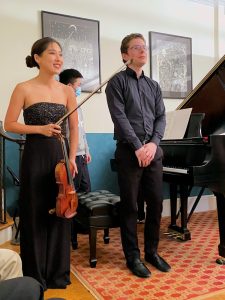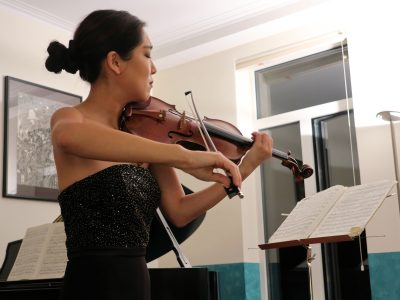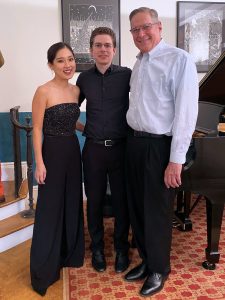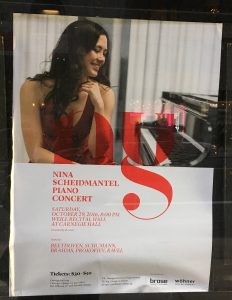Grace Park and Joseph Liccardo
On December 13th, 2021, 2018 Naumburg Violin Competition winner Grace Park will give a recital at Carnegie Weill in partnership with pianist Joseph Liccardo.
On December 4th, Grace and Joseph previewed their all-French Carnegie program at Robin Shoemaker’s New York salon. The program spans from the 17th century to the 20th.
Ms. Park explained that it starts with the ethereal (Messiaen), progresses to the dreamy (Fauré), steps back to get grounded (Leclair) and culminates in the clarity of Saint-Saëns.
Messiaen: Thème et Variations
Thème et Variations opens with a plaintive motif that evolves through 5 variations. Ms. Park’s violin flowed over Mr. Liccardo’s nuanced and at times surreal accompaniment. The work peaks in the 5th variation, and the violin gradually steps down to a long, fading B over rolling piano bass. It was simply stunning.
Fauré: Sonata No. 2 for Violin and Piano in A major Op. 100
Ms. Park launched attacca into Fauré. We knew to expect this, yet there was applause at the end of Fauré’s first movement. Perhaps this was due to the closing flourish of that allegro molto. Or did the audience think that it was still Messiaen?
Fauré’s sonata contains hints of César Franck’s Sonata in A major, composed decades earlier. Both have that wistful, dreamy French feel. My favorite part was the andante, where pianist Joseph weaved a translucently evocative dialog with the violin.
Leclair: Violin Sonata in D major Op. 9 No. 3
Stepping back to the 17th century, Fauré’s cloudy impressionism was banished by Leclair’s baroque sunshine. Ms. Park’s ornamentation was well-articulated and her double-stopping was strong and satisfying. The final movement (Tambourin: Presto) was a manic folk-dance that had us chuckling.
Saint-Saëns: Sonata No. 1 in D Minor Op. 75
Saint Saëns writes engaging, almost cinematic music, and his Sonata was captivating. We were struck by how well-coordinated the musicians were, no matter how challenging the material.
The work opens as a bumpy Allegro Agitato. The piano variously leads, mirrors and follows. While occasionally it takes the foreground, more often its role is to underpin the irrepressible violin.
The final movement is a rambunctious Allegro Molto. It was breathtaking to watch Grace’s tiny fingers work the fingerboard while her bow danced and Joseph’s piano pulsed tirelessly. Their spirited performance earned a standing ovation.
Closing thoughts
When Grace Park (https://www.graceparkviolin.com/) performed at this venue in 2018, she used a 1799 Nicolas Lupot violin.
This time her violin was a 1739 Montagnana. “I love the brilliance of the instrument”, she told me, “the soul of a soprano”.
We love the brilliance of the Grace Park/Joseph Liccardo duo. Collaborating for over 7 years, their coordination is uncannily perfect and their refined musicality a delight.
Finally, there’s still time to get tickets for their December 13th recital at Carnegie Weill.




You must be logged in to post a comment.